Production of Grouper
Production of Grouper
Groupers are important fish, particularly for live seafood markets in several Asian countries and highly prized for the quality of their flesh. Orange spotted grouper, Epinephelus coioides inhabits a depth of at least 30 m, over mud and rubble in shallow reefs and lagoons; while the juvenile are found in the shallow waters of estuaries over sand, mud and gravel and among mangroves. It is eurythermal and euryhaline. It feeds mainly on fish followed by crustaceans and molluscs. It is a diandric protogynous species, where male is either derived from a juvenile phase or the transition from post spawning female. The female matures at 320 mm size at an age of 2 years, whereas the primary male matures at 242 mm size at an age of 1 year. The sexual transition occurs at a size of 550-750 mm at the age of 5-6 years. The major spawning period is March to June. It probably spawns during restricted periods and form aggregations for spawning after the full and new moon.
Epinephelus coioides
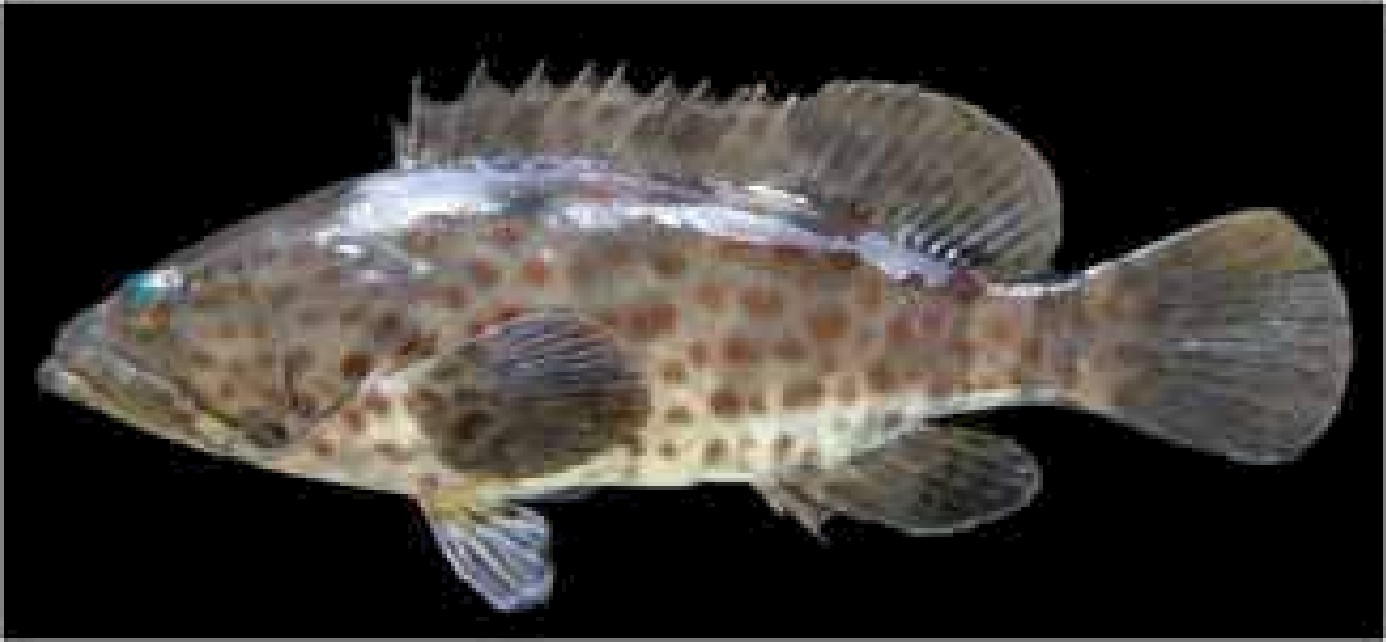
Seed Production
Broodstock management
For developing broodstock, the adult fish weighing not less than 2 kg are sourced from wild using hook and line or from a farm. The collected adult fish are given mild sedation using 50 ppm 2 phenoxyethanol solution and transported in covered tank containing aerated water. After arrival in the hatchery, the gas filled in the air bladder (barotrauma) is removed by inserting a needle in to gas bladder through anus.
Collected fish from wild showing barotrauma
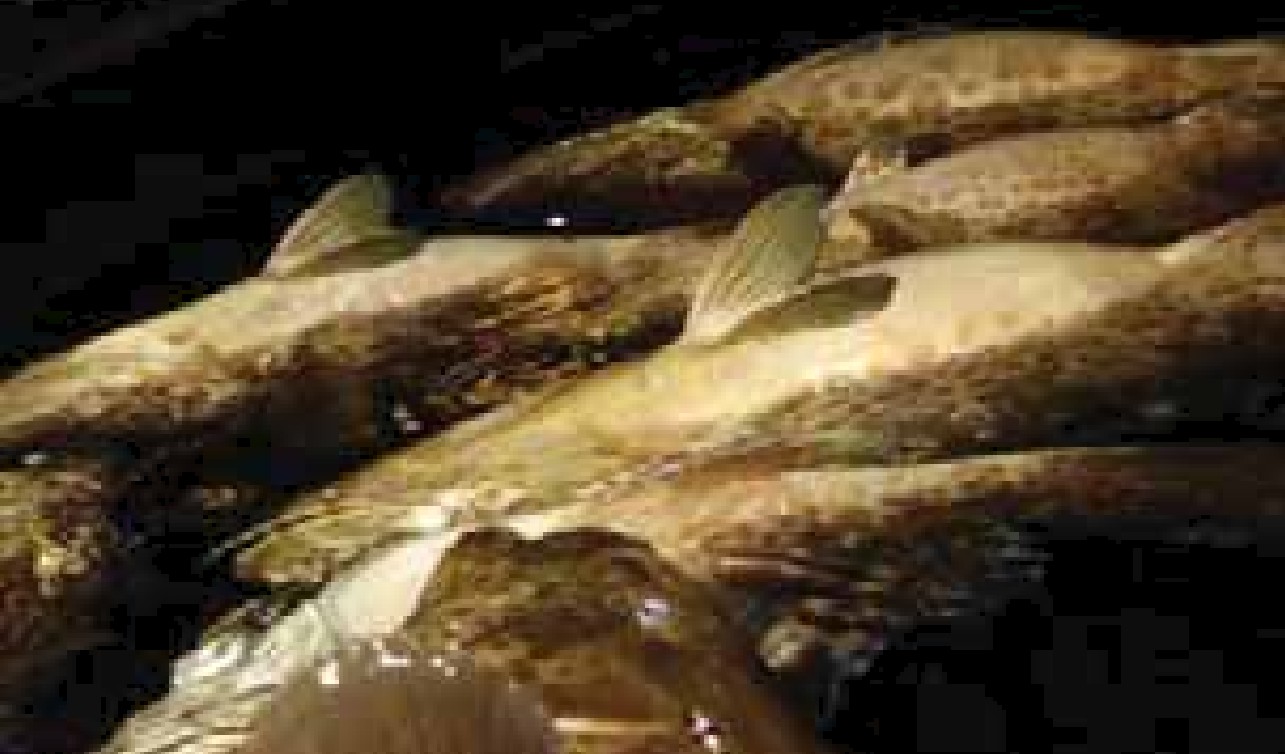
Once the fish is swimming normally with controlled buoyancy by maintaining its position in the water column, it is shifted to quarantine area for 2 weeks, where it is provided with a bath in 200 ppm formalin solution for 30 minutes followed by 5 minutes dip in freshwater, once in every 3 days. After quarantine, the fish are transferred to maturation cum spawning tank (125 t capacity) having re-circulatory water system. The fish is fed to satiation once daily in the morning with fresh or frozen squid. Micro nutrients namely, vitamin A, vitamin B-complexes, vitamin C, vitamin E and vitamin—mineral mix are supplemented once a week along with the feed.
Maturation cum spawning tank
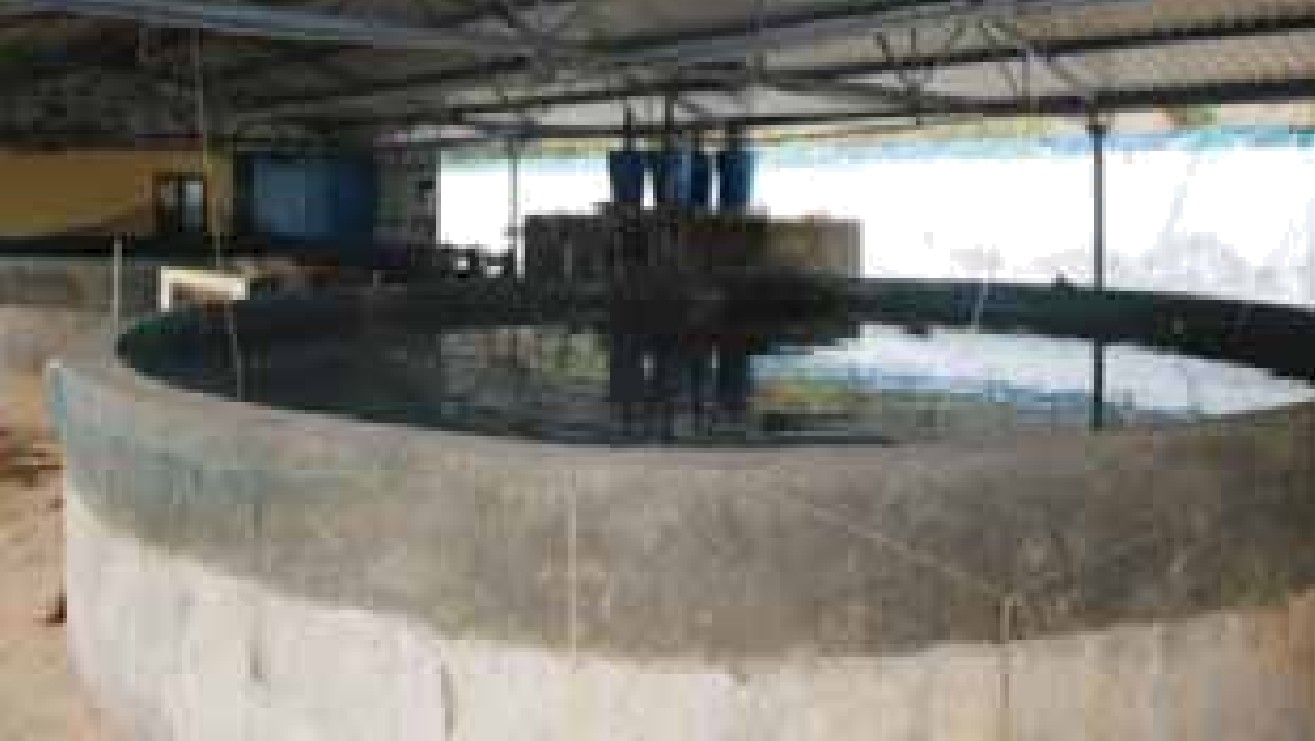
After one month, the fish are cannulated using fish cannula or baby feeding tube CH-6 having an inner diameter of 1 mm and outer diameter of 2 mm for collecting gametes. After anaesthetising the fish using 200 ppm 2-phenoxy ethanol for 2-3 min, the cannula is guided into the urino-genital orifice of male and the oviduct of female for a distance of 6-7 cm into the body and suction is applied to the other end of the cannula as it is withdrawn. After withdrawal, the sample within the cannula is expelled onto a microscope slide for immediate examination or into a vial containing l% neutral buffered formalin for later measurement of egg diameter.
Cannulation of orange spotted grouper

Water quality management
Re-circulatory water system connected with maturation cum spawning tank will provide optimum water quality for the fish. The water quality management practices are similar to that explained for the milkfish.
Sex Reversal
Generally the wild collected fish is female; however, both sexes are required for the spawning purpose. Hence, 50% of fish are implanted with pellet containing 17 o methyl testosterone and letrazole @ 5 mg/kg and 0.2 mg/kg of the body weight respectively. The pellet is prepared using gum acacia, cholesterol and 17 alpha methyl testosterone in the ratio of 1:2:1. The pellet is implanted on dorsal side of the broodfish below to the dorsal fin in musculature. The female is converted to male within 2 months after pellet implantation.
Spawning
Natural spawning starts from 4th month onwards after stocking, and they spawn 4-10 times in a month. The spawning continues round the year. Generally fish spawn during evening hours before sunset. The spawning pair shows courtship behavior with a typical vertical burst of swimming just before release of gametes. Fertilisation occurs externally and fertilised eggs are transparent and floating in nature having 850-900 micrometer diameter with a single oil globule. On an average, 2-3 lakh fertilised eggs are collected from each spawning.
Incubation
After 14 hours of spawning, the eggs are collected using hapa net (1x1x1 m) of 500 pm mesh size fixed in the egg collecting chamber. The collected floating eggs are disinfected with 20 ppm active iodine solution for 10 minutes and stocked in aquarium (100 1 capacity). Fertilisation rate is estimated by taking sample from aquarium. The fertilised eggs are either incubated in the aquarium at a density of 400 no./l with mild aeration or directly stocked into indoor nursery-rearing FRP tank (2 t) at a density of 10 no./l. The eggs hatch-out within 18-20 hours at 28-30oC. Average hatching rate is more than 85%. The newly hatched larva has an average total length of 1.6 mm with yolk sac. Mouth of the hatchling appears after 48-56 hours with an opening of about 120 micrometer.
Live feed production
The production method is same as that explained for other marine finfish. Live feeds used for orange spotted grouper larval rearing comprises of microalgae (Nannochloropsis sp. and Isochrysis sp.), copepod nauplii and adult (Parvocalanus crassirostris), small rotifers (Brachionus rotundiformis), large rotifers (Brachionous plicatilis) and brine shrimp (Artemia) nauplii.
Rearing of larvae
The sea water used in larval-rearing tank is passed through sand filters to remove particulate matter and is then sterilized by ozone treatment to eliminate pathogens. Generally fertilised eggs are stocked in larval rearing tank just before hatching.
Eyed stage eggs before hatching
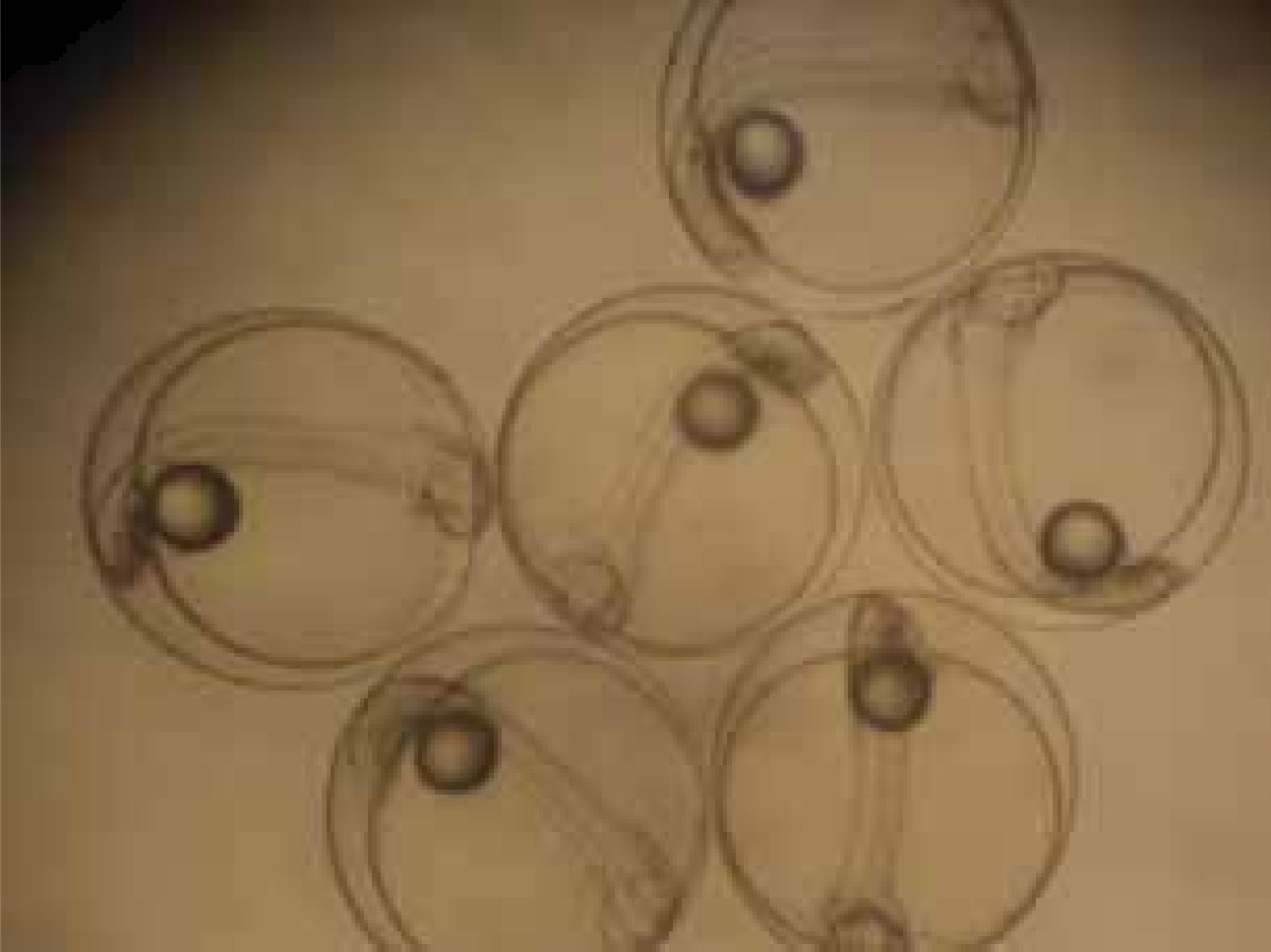
After hatching, bottom of the tank is siphoned to remove any un- hatched eggs as well as eggs shells. Tank is covered with black cloth till the first feeding. Oil is added to form a thin film on the water surface (around 0.2 ml/m2) during 1st to 4th dph for preventing surface aggregation mortality in early-stage grouper larvae. The yolk sac (endogenous source) provides nutrient for 2-3 days in grouper larvae. Then, the exogenous feeding starts when the mouth opens after the 3rd day. Its initial mouth gape is very less and therefore, it has to be provided with appropriate size of feed i.e. copepod nauplii and screened rotifers. Nannochloropsis sp is introduced into the larval-rearing tank on 2 dph at an algal cell density of 1x105 no./ml. Rotifers filtered with 80 qm mesh and copepod nauplii filtered with 100 um mesh are introduced into the larval rearing tank on 2 dph, after the larval mouth opening has been formed. The rotifer and copepod nauplii density in the larval- rearing tank is maintained at 5-7 and 2-3 no./ml during 2 to 5 dph. After 5 dph, small rotifers (filtered with 150 qm mesh) are introduced at density of 10-15 no./ml, which is gradually increased to 20 no./ml from 11 to 18 dph. Freshly hatched-out Artemia nauplii are used as feed at density of 0.5 no./ml from 17 dph and their size increasing with advancement in rearing period. Adult copepods are given as feed during 16 to 20 dph in larval-rearing. Weaning of grouper larvae with artificial diet starts from 20 dph. Artificial diet with a particle size of 200-300 micrometer is used initially. The formulated feed is sprinkled onto the surface of the water in small amounts frequently throughout the day. The size of particulate feed is increased to 400-800 micrometer from 30 to 40 dph.
The larval rearing tank is maintained without water exchange until 7 dph, and then from 10 dph, 5-10% of daily water exchange is required to maintain the water quality. Bottom siphoning of the tank should be started on 7 dph. From 12 dph, faeces, dead larvae and uneaten food which accumulate on the tank bottom should be siphoned out at least once daily for maintaining the water quality. Daily water exchange is increased to 20%, when both rotifers and Artemia are given together as feed (15 to 20 dph) and it is gradually increased to 50% from 25th dph, and 100% from 35 dph onwards.
Metamorphosis of larvae takes place within 30-40 dph. Cannibalism is a serious problem during metamorphosis due to its size variations which can be controlled by proper size grading and by increasing feeding frequency.
Metamorphosed larvae
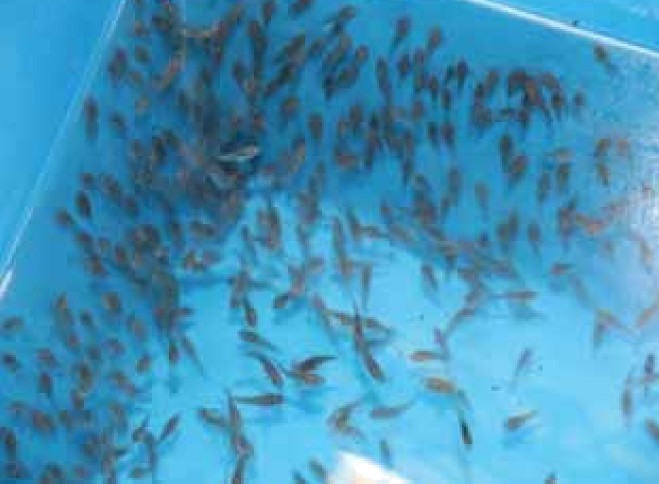
Rearing of fry
After 40 dph, the larvae are shifted from larval rearing tank to fry rearing tank. Fry rearing is carried out in light coloured tank. The seeds of 1.5-2 cm are stocked at 1000 no./m3. During the fry rearing, the larvae are size graded once weekly, to avoid cannibalism. The fry is fed initially with a formulated micro-encapsulated feed of 800-1000 qm size and progressively changed onto an extruded larval feed of 1.2 mm by 50 dph. Water is exchanged 100% daily. Feeding frequency varies from 5-7 times in a day. The seed is harvested at 5-6 cm size by 60 dph.
Second phase of nursery-rearing is required for growing 5-6 cm to 10-15 cm for stocking in cage as well as in pond. During this period, the fingerlings are reared either in pond based hapa (4 mm mesh size), flow through cement tank or in re-circulatory system. The fry is fed with a floating pelleted feed with 45% protein and 10% fat of 1.2 mm and 1.8 mm sizes @ 10% of the body weight thrice in a day.
Orange spotted grouper fingerlings
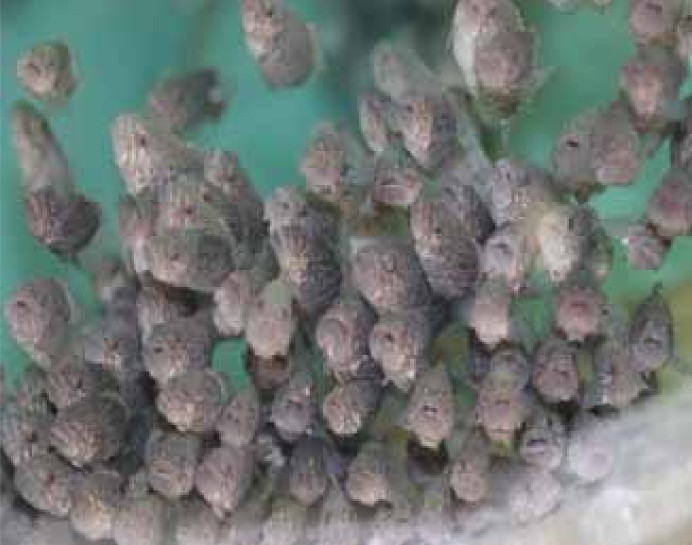
Packing and transportation
The seed is usually transported for long distances in oxygenated plastic packet @ 10 no./l and for short duration in open tank system with oxygenation or/and aeration. DO level is maintained above 8 ppm using oxygen cylinders. Fish is starved for 48 hours before transportation.
Farming in Cage
Site selection
The farming of grouper is preferably carried out in cage. A calm area with more than 10 m water depth, 30-50 cm/s water current velocity with sandy or muddy bottom is suitable for sea cage farming.
Water quality requirement
The optimum water quality requirement is given below.
Salinity : 15-35ppt
TAN : < 0.1 ppm
Temperature : 23- 30°C
DO : > 5 ppm
Nitrite : 0.05 ppm
Cage design
Cage made up of HDPE or GI material are used for culture of grouper. The size of the cage (diameter and depth of net) depends upon operation feasibility. Circular cage of 6 m diameter and 4 m net depth are easily managed with the involvement of 5-6 people. HDPE cage is better for off shore cage farming while GI cage is used in protected areas or in backwaters.
Different mooring systems are used for cage culture such as grid type anchoring system, single point mooring, etc, based on the suitability of the site selected. Generally, cement blocks connected with 14 mm alloy steel long linked chains are used for single point mooring of the cages, which allow free movement of the cage in 360° depending upon the current direction.
Circular HDPE cage
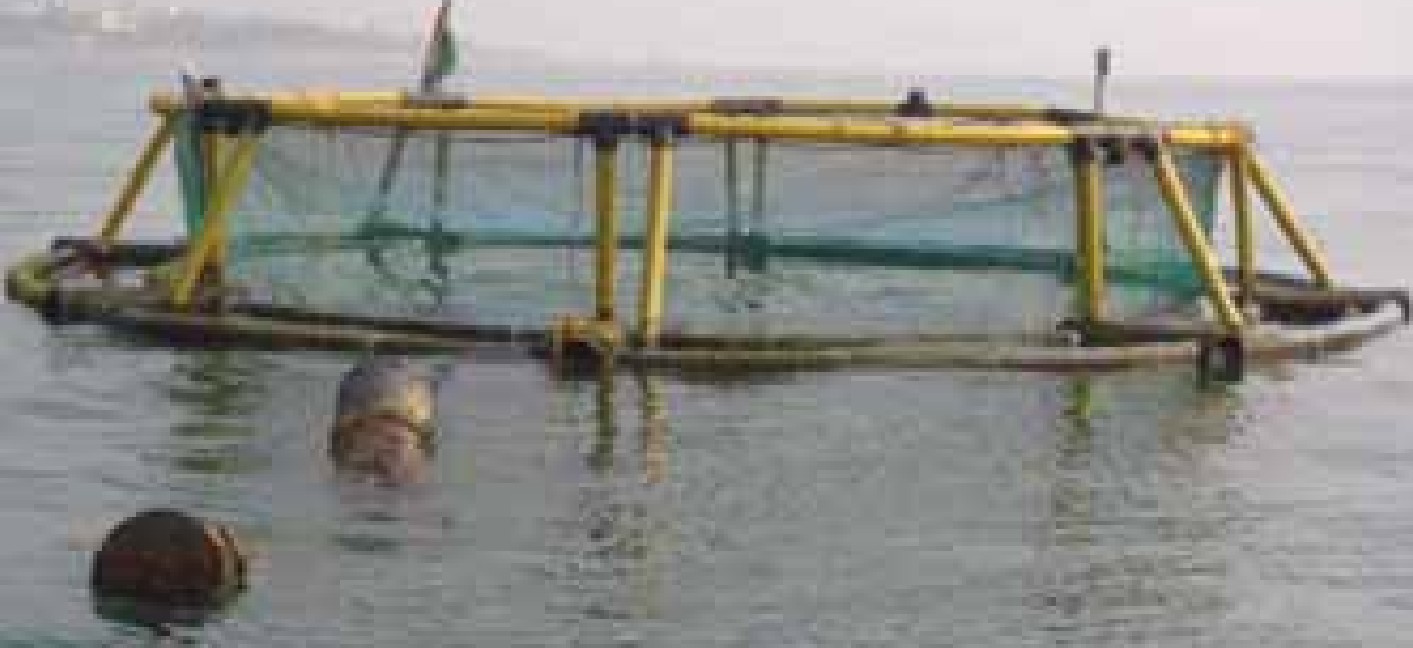
The cage bag is a flexible mesh material, which can be prepared by different synthetic materials, including HDPE, polyester (PES) and polypropylene (PP) or polyamide (PA). Among all, the Polyester material offers economic and technical advantages such as breaking strength, resistance to fouling and resistance to abrasion. The square shaped mesh size is always preferred and to get the proper shape, the net panel is attached to head rope with a hanging ratio (E) of 0.71 to produce square meshes, which helps against fouling and provides maximum surface area. Two net bags are used in a cage, i.e., inner and outer net bags in inner ring and outer ring of the cage respectively. The mesh size of both the net bags depends on the size of the fish stocked for culture. Initially, inner mesh size of 6-8 mm are used then increased to 12 mm after 3-4 months and finally, 18 mm mesh size is used after 6 months. A ballast of 60 kg weight is attached to the bottom ring of inner cage net to maintain the shape of the net bag.
Stocking and feeding
After acclimatisation, the seeds of 30 g size are stocked at a density of 35 no./m3 in rearing cage. After 4-5 months of culture period, the stocking density is reduced to 20 no./m'. The fish are initially fed with pelleted feed having 40-45% protein and 10-12% fat, @ 8-10% of the body weight as two rations in morning and evening. As the fish grows to a size of 100 g, it is fed with low value fish @ 10% of the body weight twice in a day.
Care and maintenance
Cage with net and mooring system should be checked periodically during the culture period. Generally algae grow on the cage frame, which makes the frame slippery, hence it is scrapped once in a month to keep cage frame clean, so the worker can easily work by standing on the cage. The chain and floats attached to the mooring system is inspected not later than once in a month for any damage such as shackle loosening and chain damage. If any damage is noticed, it should be repaired immediately. The mooring system is compulsorily checked after every bad weather conditions such as cyclones, storms, depressions, etc. As the cage net is always inside the water, settlement of fouling organisms such as barnacle, algae, etc would happen; hence it is frequently checked for assessing the extent of fouling and if 50 % of the net meshes are clogged, the net must be replced. The inner net of the cage should be changed every month for first three months, followed by once in two months. The net must be checked frequently for any damage.
A warehouse and a boat with 24x7 round the clock security including watchmen and CCTV camera are provided for the storage and transportation of feed, net, etc. For net exchange, ballast is released from the inner net and hang freely in the outer cage net with help of PP rope. Inner nets are lifted half, followed by inserting the cleaned net from one side of the cage frame to the other side and tied on the hand rail. Then, the older net knots are released from the hand rail and the net is dragged from one side to the boat, while doing so, the fish will move from the older net to the cleaned net from the other side of the net. Then the nets are dried in sunlight and cleaned and repaired.
Harvested orange spotted grouper
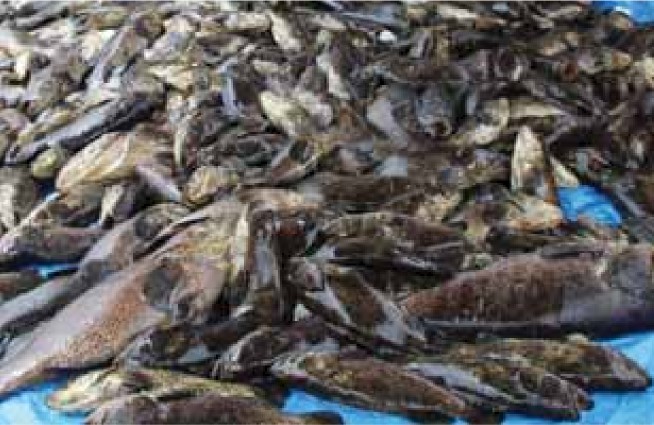
The fish stock is regularly observed without unduly disturbing them and this provides a general understanding of how they behave under normal environmental conditions. If something wrong is observed, then fish are sampled and examined. Fish sampling is done at least every month, so that their growth is monitored regularly. This information is required for calculating the feed requirement for the stock. It will give a fair idea about the stock performance and the feed requirement for the future. Records of the farming practices such as daily mortality, feed consumption, and growth rate should be maintained. It is crucial in understanding the epidemiology of diseases and allows to identify the critical management point in the production cycle. The growth pattern is given in Table below.
Growth rate
| DOC | ABW in g |
| 0 | 30 |
| 30 | 52 |
| 90 | 110 |
| 150 | 268 |
| 210 | 455 |
| 270 | 735 |
| 330 | 1070 |
| 390 | 1420 |
Harvesting
Harvesting of fish is done continually or in batches depending on how the production cycle is managed. Before harvesting, the fish are starved for a day to have empty gut, which helps in increasing the shelf life of the produce. Fish are harvested in-situ or the cages are towed to convenient places where the netting operation is carried out without any obstacles. The process of harvesting is simple, where the net is lifted up and the fish are concentrated to a small volume and scooped out and are then placed into a chilled container, chill killed and packed in ice, prior to transportation. A production of 16 kg/m3 is expected from one crop with survival rate of 80-90%.
Last Modified : 12/29/2022
ICAR-Central Institute of Fisheries Technology COV...
This topic provides information about Trout Cultur...
This topic provides information about Marine Fin F...
Provides summary of District Agriculture Plan Wash...
